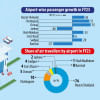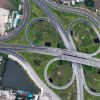Padma Bridge opens door to opportunities

The dream of establishing road connectivity between the southwestern part of Bangladesh and the capital city came true after the opening of long-waited Padma Bridge in June.
But it will take time to make the most out of the country's longest bridge since a supportive infrastructure is yet to be built in the region, home to 21 districts.
Unavailability of gas, low electricity infrastructure and narrow roads from Bhanga of Faridpur to the southwestern part are the major obstacles standing in the way of industrialisation in the area, according to businesspersons and experts.
Because of a lack of a government holistic plan, an expected investment environment has not been created, they say.
"The bridge has broken a psychological barrier among entrepreneurs about the transportation problem in the southwest region, so they are thinking about making investments," said Selim Raihan, a professor of economics at the University of Dhaka.
He co-authored a study on the economic impact of Padma Bridge in 2010, much before the actual implementation of the project took off.
According to the study, Bangladesh's economy would expand by 0.33 per cent to 1.26 per cent annually and that of the southwestern region by 1.66 per cent to 2.3 per cent thanks to the bridge.
"However, the potential may be unrealised or take long to be tapped if barriers to investment can't be eradicated," Prof Raihan told The Daily Star recently.
"The potential will not be materialised automatically."
In order to make the investment climate attractive to entrepreneurs, the economist proposed ensuring an adequate supply of gas, electricity and land, widening of roads and elimination of red tapes.
One of the immediate tasks for the government would be to set up a new economic lifeline on the two sides of the Dhaka-Kuakata highway on a priority basis.
"Banks also need to come forward offering new schemes," added Raihan, also the executive director of the South Asian Network on Economic Modeling.
ABUNDANT INVESTMENT OPPORTUNITY
Many local conglomerates have already acquired land to build industries, while many entrepreneurs are looking for scopes to invest.
For example, Fortune Shoes plans to set up a technology-based and agro-based factory in Barishal by investing more than Tk 500 crore, said its Chairman Mizanur Rahman.
"The Padma Bridge has opened up opportunities for the southwestern region, especially Barishal," said Sydur Rahman Rintu, president of the Barishal Chamber of Commerce and Industry.
As the Kuakata beach is closer to Dhaka compared to Cox's Bazar, it would be a more attractive destination for tourists. As a result, more hotels will be set up, said Motaleb Sharif, secretary of the Kuakata Hotel & Motel Owner's Association.
The Khulna region has the potential for the development of various industries such as jute, export-oriented shrimp, leather, salt, shipping, cement, rod, liquefied natural gas, betel nut, coconut, vegetable, agro products, and marine and dried fish industries.
Above all, a number of tourism industries can be developed centring the World Heritage Site Sundarbans, the biggest mangrove forest in the world.
GOVT WORKING TO IMPROVE INFRASTRUCTURE
The government is not sitting idle.
It has built four bridges to facilitate the connectivity from Barishal to Kuakata, but roads are still narrow, according to Rintu.
The government plans to upgrade the highway from Bhanga to Kuakata of Patuakhali to a four-lane.
It looks to set up economic zones in Hizla of Barishal and Patuakhali. The land acquisition process has not been completed yet.
A land acquisition proposal has been sent to the Prime Minister's Office and the local administration would start handing over the money to the land owners after getting the approval, said Patuakhali Deputy Commissioner Kamal Hossain.
The Khan Jahan Ali Airport will be set up at Foyla Bazar on the Khulna-Mongla Highway, which is 95 kilometres from the Jashore airport.
The Executive Committee of the National Economic Council approved a project in May 2015. The construction was expected to be complete by June 2018. Initially, the government acquired 102 acres out of the planned 536 acres.
Speaking about the current investment situation in Khulna, Pronab Kumar Roy, a director at the Khulna office of the Bangladesh Investment Development Authority (Bida), says many foreigners want to invest in Khulna. However, their number has fallen short of expectation.
According to the Khulna Divisional Office of the Bida, 103 companies collectively invested Tk 17,140 crore from 2016 to 2021.
MORE NEEDS TO BE DONE
"I think the overall communication network is not up to the mark for investors. There is no airport in Khulna. This is another barrier to the investment," said Roy.
Sheikh Ashraf-uz-Zaman, president of the Greater Khulna Development Coordination Committee, thinks the hopes of wooing investments have grown following the inauguration of Padma Bridge.
However, development in the region would not be materialised unless gas is supplied and a smooth communication network is ensured.
Because of a lack of proper development of Mongla seaport and Benapole and Bhomra land ports, foreign investors will not be encouraged to come to the Khulna region, said Kazi Aminul Haque, president of the Khulna Chamber of Commerce and Industry.
"Even many local investors have set up factories in Dhaka due to an absence of adequate facilities in the area."
The Khan Jahan Ali Airport project is supposed to build under a Public-Private Partnership arrangement. But Haque urged the government to set up on its own.
"An Indian investor agreed to invest in the region but backed away after finding out that there is no airport there."
GAS, POWER SUPPLY HOLDS KEY
Unavailability of gas is a big problem in Barishal. The southern division does not have any natural gas connection.
"Electricity is available in the region but the concern remains whether it is capable of ensuring uninterrupted power supply for industries," Rintu said.
Thanks to the opening of Padma Bridge, massive industrialisation may take place in the southwestern part and this will lift the electricity demand to 930 megawatts from 667 MW now, said Md Mustafizur Rahman, chief engineer of the West Zone Power Distribution Company Ltd (WZPDCL).
The current distribution line of the company stands at 12,425 km.
The construction of six substations and about 1,200km of new distribution lines is under implementation in the Khulna-Bagerhat area. These are expected to be implemented within two years.
Another 22 substations with new lines of about 2,500 km are under construction in the other areas under WZPDCL, which supplies power to 21 districts.
Gas Transmission Company Ltd (GTCL) has already constructed a 163-km gas transmission pipeline from Bheramara in Kushtia to Aranghata in Khulna via Jhenaidah-Jashore.
The plan to set up a gas distribution network has been taken so that Sundarbans Gas Company Ltd (SGCL) can supply gas from the GTCL's transmission line to economic zones, export processing zones and the industrial belts under the Bangladesh Small and Cottage Industries Corporation (BSCIC) in Khulna, Jashore, and Jhenaidah.
Md Salahuddin, general manager for plan and distribution at SGCL, said: "At present, we will not provide gas to any individual industry. Factories must be set up in the economic zones or industrial belts."
So, the government official requested investors to set up companies in government-approved industrial zones for getting gas facilities.


 For all latest news, follow The Daily Star's Google News channel.
For all latest news, follow The Daily Star's Google News channel. 








Comments